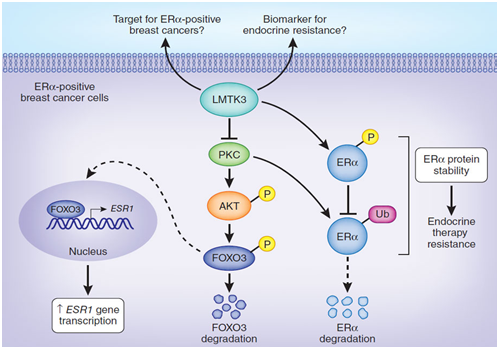ESR1a
In the clinic, the estrogen receptor (ESR) and more precisely the estrogen receptor α (ESR1α) is an important prognostic disease marker. Approximately two-thirds of breast cancers are ESR1-positive. The binding of estrogen to the ESR1 is not only a key regulator for the physiological growth and differentiation of the mammary gland, it is also a key element in the malignant progression of breast cancer, i.e. the growth of ESR1 expressed breast cancer cells is stimulated by estrogen, which in turn makes it accessible to endocrine treatment strategies, while breast cancers that do not express ESR1 exhibit a primary resistance to endocrine treatment.
Therefore, the presence of ESR1 correlates with increased disease-free survival and a better prognosis when compared to ESR1-negative breast cancers. While at the time of diagnosis up to one-third of breast cancers are ESR1 negative, quite a few cancers that are initially ESR1 positive lose the ESR1 during the course of tumor progression and are therefore no longer responsive to endocrine therapy designed to block ESR1 function.Tumor growth is estrogen independent in approximately one-third of all breast cancers, which makes these patients unresponsive to hormonal treatment. This unresponsiveness to hormonal treatment may be explained through the absence of the estrogen receptor alpha (ESR1). The ESR1 gene re-expression through epigenetic modulators such as DNA methyltransferase inhibitors and/or histone deacetylase inhibitors restores tamoxifen sensitivity in ESR1 negative breast cancer cell lines and opens new treatment horizons in patients who were previously associated with a poor prognosis. Ribavirin and analogs could pave the way to novel translational research projects that aim to restore ESR1 gene re-expression and thus the susceptibility to tamoxifen-based endocrine treatment strategies.
Estrogen receptors are a group of proteins found inside cells. They are receptors that are activated by the hormone estrogen ( 17β-estradiol ). There are two different forms of the estrogen receptor, usually referred to as α and β , each encoded by a separate gene ( ESR1 and ESR2 , respectively). Estrogen receptors are over-expressed in around 70% of breast cancer cases, referred to as “ER-positive. Two hypotheses have been proposed to explain why this causes tumorigenesis , and the available evidence suggests that both mechanisms contribute:
- First, binding of estrogen to the ER stimulates proliferation of mammary cells , with the resulting increase in cell division and DNA replication, leading to mutations.
- Second, estrogen metabolism produces genotoxic waste.
The result of both processes is disruption of cell cycle , apoptosis and DNA repair , and, therefore, tumour formation. Different versions of the ESR1 gene have been identified (with single-nucleotide polymorphisms ) and are associated with different risks of developing breast cancer. Estrogen and the ERs have also been implicated in breast cancer, ovarian cancer, colon cancer, prostate cancer, and endometrial cancer.



